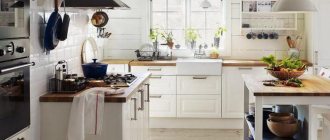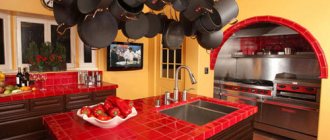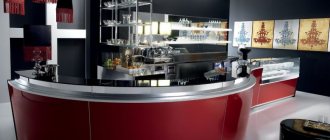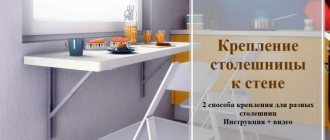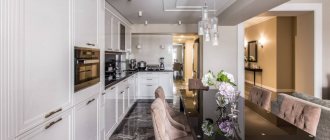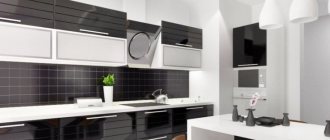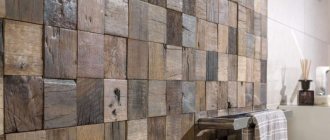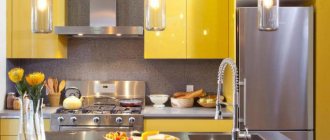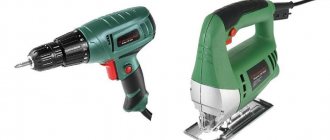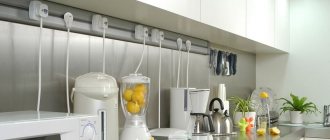Why is a wooden countertop not scary?
On the one hand, smooth, warm wood with a beautiful natural structure is an excellent material for furniture production. Easy to use, environmentally friendly, always fashionable and relevant. Moreover, the tabletop is not a heavy wooden buffet that is impossible to move. It is not necessary to make all the furniture from wood; a completely reasonable modern solution would be to make only the tabletop and, perhaps, some other individual parts from this material.
But many are afraid of how wood may behave, they are afraid of fungus, cracked varnish...
But professionals think differently: “A wooden countertop is not a problem if you apply reasonable, adequate care to it. There are not many materials used for countertops in non-professional kitchens that are not afraid of any impact and do not require maintenance, says Andrey Lyamin-Borodin, builder, general director of the online repair ordering service PriceRemont
. “All materials age during use, but the peculiarity of wood is that it can age gracefully.”
So what are we dealing with? Mikhail Vychuzhanin, wood finishing specialist, North House
, defines the advantages and disadvantages of wooden countertops like this.
- environmental friendliness of the material;
- beauty and variety of wood texture;
- unlimited product parameters: almost anything can be made from wood in any way;
- easy to update;
- the ability to perform any milling of the edge of the tabletop.
- more careful care is required;
- restoration will be needed after some time;
- relative high cost of the material and work with it.
Creating a joinery panel for a wooden tabletop
Before assembling the joinery panel, the wood should be carefully prepared. Before covering the wooden countertop elements in the kitchen with an antiseptic, they must be treated with a jointer and sanded.
Advice. For more durable use of furniture, its elements are not only glued together, but also fastened in one of the convenient ways.
The most reliable way to fasten boards is using the tongue-and-groove method:
- Using a manual or automatic cutter, ridges and grooves are made.
- The tabletop elements are connected to each other using the method used, the contacting surfaces are treated with wood glue.
The groove in the tongue-groove connection is made with dimensions of 10×10 mm or 15×15 mm, a size of 6-8 mm is allowed when using thin boards
Advice. For greater reliability of the structure, a transverse beam can be secured to the bottom of the wooden tabletop. It is attached to the main part of the furniture using self-tapping screws.
Which wood to choose for the countertop?
Here is the answer to the question of what types of wood and wood characteristics are worth paying attention to.
“When deciding on a wooden countertop in the kitchen, please forget about MDF, chipboard and veneer. Only natural wood, advises Artyom Lepyoshkin, General Director of the House of Interior Solutions Dynasty
. It's not a matter of harmfulness, but of the properties of the material. The countertop is exposed to aggressive human influence every day: crumbling, cutting, whisking, spilling and spilling are a common occurrence in the kitchen. The surface must be durable, smooth, resistant to cuts, moisture and temperatures.
The classic option is oak or beech: strong and durable wood species. Some choose teak and mebrow. More affordable options: pine, walnut, ash, birch. We prefer larch: you will have to pay more, but it will also last longer. The peculiarity of larch is the very high density of wood; the growth rings are located along the trunk with small intervals. It easily tolerates mechanical damage and deformation, and can withstand high compression and pressure loads. It contains gum, a natural antiseptic that protects against rotting and damage by mold. Ideal for the kitchen. Larch gives off and absorbs moisture when humidity changes.
The manufacturing method also affects durability. A solid wood tabletop is more likely to warp than a laminated wood tabletop assembled from several plates. This method increases flexibility and elasticity.”
“Attention should be paid to such points as: the age of the wood, the method of its extraction, storage conditions, the region where the material was brought from,” adds Mikhail Vychuzhanin
. He considers oak to be the best type of wood for making countertops. — The stronger and harder the wood, the longer your countertop will serve you. There are countertops made from solid birch, cherry, and walnut.”
Types of wooden countertops
Solid wood countertops for the kitchen are premium furniture, so they are expensive in retail sales; many are considering the option of creating them on their own. In addition to them, there are glued or prefabricated models, tabletops, which are a shield made of wooden plates.
The following types of wood are best suited for making wooden countertops:
- cherry;
- cherries;
- oak;
- nut.
Remember. There are also harder wood species in nature, but they are susceptible to changes in temperature and humidity. The types mentioned above have a good combination of hardness and elasticity, which is necessary to create a wooden countertop for the kitchen.
How to cover a wooden countertop in the kitchen
The ideal option for protecting a wooden tabletop is a bio-impregnation based on natural vegetable oils and beeswax - that is, oil-wax for wood. Natural oils for wood can make its surface waterproof, which means that the wood is not afraid of fungus and mold. By the way, a countertop impregnated with high-quality oil and wax becomes resistant to standard kitchen detergents—nothing bad will happen to wood from diluted household chemicals. It is even better and more reliable to treat the kitchen work surface with a special oil for wood that comes into contact with food. And of course, no one has canceled the more familiar coatings - interior varnish for wood or a combination of colored azure with subsequent application of varnish.
How to cover a wooden countertop in the kitchen: Belinka
With the question of how to protect the wood of the tabletop, we turned to the chief technologist of TM Belinka Valery Ermakov
.
“The ideal option for protecting a wooden tabletop is a bio-impregnation based on natural vegetable oils and beeswax - that is, oil-wax for wood. Natural oils for wood can make its surface waterproof, which means that the wood is not afraid of fungus and mold. By the way, a countertop impregnated with high-quality oil and wax becomes resistant to standard kitchen detergents—nothing bad will happen to wood from diluted household chemicals. It is even better and more reliable to treat the kitchen work surface with a special oil for wood that comes into contact with food. And of course, no one canceled the more familiar coatings - interior varnish for wood or a combination of colored azure with subsequent application of varnish.”
How practical is a wooden tabletop?
How to protect wood besides using wood products?
If you want the tabletop to last longer and maintain its appearance, follow simple rules: do not cut anything directly on the wood (perhaps only oak will endure such violence), do not test the surface for fire resistance and heat resistance. Very hot objects can darken wood, ash is especially sensitive. But if you spill wine or juice on the surface, just wipe it with a damp microfiber cloth. Do not use wet rags, this will cause the wood to swell.
We also do not recommend using aggressive household chemicals to wash the countertops. It happens that drops of such a product fall on the countertop when cleaning the sink or hob. If this product contains, for example, a solvent, it can change the color of the wood and whiten it. An important rule when any stains get on the countertop is to not allow them to be deeply absorbed and, therefore, to remove them immediately. A stain that cannot be washed off can be removed by walking over the area with fine-grained sandpaper, after which the protective coating will need to be renewed.
Regarding the choice of sink - in this case it should be mortise or, in other words, overhead. Washing an under-table installation will create constant exposure to water on the edge of the tabletop, which will inevitably cause it to deteriorate. However, lovers of country style or owners of a tabletop made of particularly water-resistant wood may not be bothered by this.
Will this countertop suit my design?
Wooden surfaces in the kitchen also offer wide design possibilities and are a current trend. Here's what designers think about it.
The world is becoming more urbanized, and people are experiencing stress due to lack of communication with nature. Natural materials in the interior, such as wood, stone, clay, help modern people feel comfortable in the “concrete jungle”.
Since wood is not a moisture-resistant material, the part of the countertop adjacent to the sink can be replaced with an artificial stone surface.
Thus, a tabletop made of solid wood with knots, uneven texture, and aging effects will suit a kitchen in a rustic or loft style. But smooth wooden surfaces will look great in modern interiors, high-tech, especially tinted in white, black or graphite - such a tabletop will combine effectively with chrome and glass surfaces. It’s worth paying attention to options made from laminated wood – perhaps even from different species: the rhythmic pattern of the elements can emphasize the beautiful geometry of the room.
kirsan_kaifat
25-12-2014 12:16
Hello. I was planning to make a beech (or oak) countertop for the kitchen from furniture panels. Unfortunately, we can’t find birch
3. Does anyone have birch shields?
sergVs
25-12-2014 12:38
1. How to change the color of steamed beech towards a lighter natural one?
quote: Originally posted by kirsan_kaifat: 2. What to cover with. impregnation or varnish?
Hard wood is better for impregnation, soft wood (pine, birch) - varnish.
kirsan_kaifat
25-12-2014 12:59
Beech, oak, ash. I’m also inclined to soak it in food flaxseed
Shyr3000
25-12-2014 14:35
vladimir beard
25-12-2014 15:36
Osmo oil with flax, especially for kitchen countertops
alex-wolff
25-12-2014 17:06
quote: Originally posted by kirsan_kaifat: 2. What to cover with. impregnation or varnish?
super unique, in three layers.
vvik
25-12-2014 17:30
That’s why parquet floors used to be rubbed with mastic, and not with varnish….
vvik
25-12-2014 17:31
As for the beech, don’t worry. In terms of performance characteristics, it is much better than birch
DocVV
25-12-2014 23:18
I suffocated from the flaxseed. You will spend months looking for a forgotten can of fish. It stinks for a long time, subtly but smelly, I'm for the varnish.
Walther
25-12-2014 23:31
Siniy Borod
25-12-2014 23:54
Wood is bleached with oxalic acid...
kirsan_kaifat
26-12-2014 10:14
quote: Originally posted by alex-wolff: super unique, in three layers.
This is what I use to cover homemade furniture.
because The kitchen is planned for spring, I have time to use any impregnation. and away from your place of residence)
kirsan_kaifat
26-12-2014 10:17
quote: Originally posted by sergVs: There was a recipe for lightening wood by treating it with peroxide and ammonia. I haven't tried it myself.
I bought a chlorine-based poison for testing. I'll torture the stool
quote: Originally posted by Shyr3000: Kiryukh, shellac doesn’t work anymore??? True, the color will turn a little red-yellow, but it will shimmer as it will....... And forget flax, it kills the beauty of the tree Z.Y. Please indicate the size of the tabletop you require... There was something similar made of birch in the store, I’ll take a look and post it.
maximum size 1500x600x40. I'll have to make a couple more smaller pieces there
quote: Originally posted by vvik: European professionals have been using toadflax and only toadflax for centuries. The reason is that any damage to the tabletop can be easily sanded, sanded and impregnated with flaxseed. No trace. It is impossible to restore any other coating on a small piece of surface without traces. That’s why parquet floors used to be rubbed with mastic, and not with varnish….
Thank you
quote: Originally posted by Siniy Borod: Wood is bleached with oxalic acid...
Thank you!
quote: Originally posted by Walther: I have an oak kitchen countertop with a total length of 8 meters. Finished with Ikea countertop oil. Both in the tail and in the mane. Super! Serves for 5 years, has not been re-processed yet. edit log
I looked at their impregnation.
same danish) they just write without drier. Max_CM
26-12-2014 10:51
Flaxseed, Danish, oil from IKEA (simple and affordable) Varnishes and especially Schellak are not suitable at all. because they create a film coating, there are fairy tales about the water resistance of shellac, even on the film of yacht varnish, if you accidentally chop it with a kitchen knife, a trace will remain.
Nowadays there are many different parquet oils, they have a natural base, are perfectly absorbed, do not create a film, in case of damage it is easy to restore, in addition, they can be tinted, that is, when applied, the tone will remain in the looser places of the texture, emphasizing it. Beech for countertops is much better than birch; birch can warp greatly.
arkuda
27-12-2014 02:03
I would be careful with beech - it really doesn’t like moisture (unless it has undergone some tricky treatment) and tears it up. But oak will be more reliable, and ash too.
kirsan_kaifat
28-12-2014 22:24
It will be impregnated before installation. there is time)
bigdad
13-01-2015 13:21
For twenty years he worked as a kitchen assembler. To impregnate the countertops made of natural wood, they were supplied with an oil like Danisha (I don’t remember the name). The tabletop was impregnated twice: the first layer was rubbed over the surface and after 2 hours of drying, the second layer was applied, which was left to dry overnight. The beech pattern became a little darker and more saturated, but not by much. I used a piece of such a countertop for five years to chop frozen meat and bones, there were no delaminations until I chopped it too hard and broke it.
kirsan_kaifat
13-01-2015 13:49
Thank you. I also found a solid birch shield. maybe I'll make one out of it
PavelTsirkach
14-01-2015 04:00
quote: The flaxseed made me choke. You will spend months looking for a forgotten can of fish.
Yongert
14-01-2015 04:38
the most important thing is to cover equally on all sides - for example, 3 layers on top - also three layers on the bottom
kirsan_kaifat
14-01-2015 11:20
quote: Originally posted by Pavel Tsirkach: Now in shops for artists they sell REFINED linseed oil, absolutely odorless.
I even saw it in the grocery store.
quote: Originally posted by Yongert: the most important thing is to cover equally on all sides - for example, 3 layers on top - three layers on the bottom as well
What is this connected with?
Yongert
14-01-2015 12:08
with the fact that if the sides have different vapor-water permeability, then the shield may fail during operation
kirsan_kaifat
15-01-2015 11:29
RMCKursk
19-03-2015 13:17
Google Rubio Monocat. Flaxseed oil, Naturel color (will lighten the countertop), apply in one layer, after 10 minutes wipe off the oil until the wood is dry. It will smell like linseed oil for two days. But then even if you put the pan on hot, there will be no trace. A 0.275 can is enough for 12 squares. So if it’s damaged, wash it, sand it, polish it and it’s like new.
demonis
19-03-2015 19:50
I'll give one more vote for OSMO. My desktop is covered with it. the table is entirely made of solid oak. I tried ZAP, Tikkurila - not the same. The effect is not the same, it also stinks. OSMO is just a blast. what about application, what about the result. I spent more money while looking for an acceptable result than OSMO cost.
Zmeyuka
19-03-2015 23:39
If OSMO is expensive, then Borma (Premier Coating) has oils for countertops or even floors. Doesn't smell like anything. Or better yet, white oil, two layers according to the instructions, and grundieroil then two more layers. Tomorrow I will add a photo of my kitchen under construction under this composition
The surface of the table in the kitchen is an essential part of kitchen furniture; it is subject to constant mechanical stress and is damaged over time. Therefore, owners of kitchen furniture ask themselves an important question: - How to cover the countertop so that it does not lose its presentation for many years?
In the kitchen, the top of the table or the area located on top of the floor cabinets is used as a work area for cutting food and preparing food, as well as a place to place household appliances and kitchen utensils. Such a working area must be resistant to shock and various mechanical damage, to the effects of temperature, ultraviolet radiation and water.
How to restore a wooden table
Before you varnish your dining table or kitchen worktop, you should evaluate the condition very carefully. The surface may already be painted, mechanically processed, glossy, or varnished. Regardless of what varnish the surface will be coated with, it is necessary to carry out preparatory work.
In the video: how to cover a table with stain.
Preparation
The first step is to remove all the old coating. This is done so that the texture of the wood is clearly visible, using an electric tool. When the table is as smooth as possible, the surface does not have any defects, then you can move on to the next stage.
To work, you will need a roller or brush, and you will also need to purchase a remover liquid to remove the old paintwork. You will also need a primer and stain, a hair dryer, and sandpaper with varying degrees of grit.
Removing old coating
The chemical remover is applied to the table surface and then wiped off after 10 minutes. To apply and remove a layer of paint or varnish, use a rag.
There is also a hot method - you need a hair dryer. The tabletop is heated and then wiped with a rag.
You can also remove the old coating by sanding. Doing this by hand takes a very long time, so it is better to use a power tool. The work is performed at low speeds so as not to damage the wood.
Varnish application technology
To apply varnish, it is better to use brushes or rollers. Using a colorless varnish for a wooden table in one layer, it is very difficult to obtain the desired shade - this is only possible if you cover the surface in several layers.
A more saturated color can be achieved by treating the table with stain or colored primers - they are applied either in one layer, or in two, three or more.
After the stains and primers have dried, they can be varnished. The varnish is applied in a thin, even layer, trying to avoid drips. After the first layer has dried, it is recommended to sand the surface. For a high-quality result, varnish in three layers of varnish.
In a day, the old table will turn into a new one and no one will ever be able to say that it is very old. Knowing how to cover a table, you can restore other wooden furniture in this way.
How to use wood varnish correctly (2 videos)
Everything you need to varnish a table (29 photos)
Wooden countertop for a rustic kitchen
The smell of strong morning coffee fills the cozy kitchen. You want to be here all the time, inhaling the aromas of freshly prepared food - fried meat, mushroom soup, sweet freshly baked muffins. Here you want to meet in the evening, have leisurely conversations after a working day, spend the weekend doing pre-dinner chores for the family, or just sit, when your family has already fallen asleep, with a cup of herbal tea. Yes, right here, behind this kitchen wooden countertop - warm, cozy, welcoming... and, it seems, eternal.
Cozy kitchen island design with a wooden countertop
A wooden countertop is one of the most successful solutions for the kitchen, practical and convenient.
How to make a countertop practical and durable? Both of these qualities are laid down initially, at the stage of choosing a wooden surface.
The countertop must be well sanded and treated with a special compound before use.
What to look for when choosing a wooden kitchen surface?
- You cannot use veneer, MDF, chipboard, only natural wood.
- Has the meaning:
- age of wood;
- place of felling;
- storage conditions.
- Products made from laminated wood are more flexible and resilient than their analogues from solid wood.
- A properly selected coating will protect the wood in harsh operating conditions in the kitchen. Before covering a wooden tabletop with oil or other suitable composition, it is worth studying the available range of coatings, their properties, and features. Even better is to test the chosen product on a small piece of wood.
- It is necessary to clearly define the methods of surface care and the possibility of restoration in case of damage.
Choose hardwood for a wooden tabletop
A wooden tabletop must be smooth, durable, resistant to moisture, temperature, and cuts. A product made from harder wood will last longer. Classic options for kitchen countertops are oak or beech. Tabletops made of ash, pine, walnut, and birch are more affordable.
Since wood is not a moisture-resistant material, the part of the countertop adjacent to the sink can be replaced with an artificial stone surface
Larch works well. Its dense wood is resistant to mechanical destruction and deformation. Gum in larch wood prevents the growth of fungi and rotting, such properties are ideal for difficult kitchen conditions. Larch has the important property of giving up or absorbing moisture when humidity conditions change.
An excellent option for a tabletop is an untreated piece of wood.
Advantages of wooden surfaces over other types:
- environmental friendliness;
- beautiful texture;
- variety of colors, shades;
- ease of processing, unlimited possibilities in creating different shapes, neat edges with the possibility of various milling;
- ease of updating and repair.
Glued table top made of wood planks
Don't forget about the disadvantages:
- requires more careful care than other types of surfaces
- periodic restoration is required;
- high cost of the material, expensive processing work.
A wooden tabletop must be protected from moisture so that it does not get wet and fungus does not appear.
In a situation with wood, you need to remember that all the difficulties in selecting, caring for, and repairing it will more than pay off in coziness, beauty and extraordinary feelings of comfort in the kitchen.
Solid wood table top for dining table
Features of wood countertops
Kitchen sets are made using various raw materials, such as wood. It can be either natural, that is, without a special composition applied on top, or coated with varnish or paint.
The table provides data on wooden tables.
The advantages of countertops made of wood are:
- a large number of different forms;
- attractive appearance;
- ease of carrying out restoration work;
- This material is environmentally friendly and warm.
The disadvantages of countertops made from wood raw materials are:
- ease of fire;
- ease of contamination;
- can be scratched easily;
- is quite expensive.
Restoration of a chipboard tabletop
A tabletop made of chipboard or solid wood can be restored with your own hands.
Important! As a rule, the main cause of furniture damage is exposure to moisture and/or high temperature. Therefore, a very reasonable solution is to preventively treat the seams of kitchen furniture made of chipboard with silicone sealant. The same manipulation will not be superfluous after any furniture repair.
Let's consider repairing a countertop made of laminated chipboard with your own hands from getting wet. When wet, the surface of the table seems to rise, becomes uneven, and the material itself loosens. To restore the original appearance of the kitchen table, proceed in this order:
- Remove sawdust resulting from delamination.
- Dry the surface well.
- Mix sawdust and PVA emulsion to the consistency of a thick paste.
- Fill the resulting voids with the resulting mixture.
- Keep the product under pressure for about a day. This time is enough for the mixture to dry.
- Clean the surface, treat the seams with silicone, and then secure with a strip.
Important! If deep scratches have formed on the chipboard surface, getting rid of them is simple:
- Sand the tabletop in two stages: first with P120 sandpaper, then switch to sandpaper with a lighter grit.
- Perform final sanding with P360.
- Now go over the surface with felt and it will look polished.
Ways to protect your kitchen work surface
The working area of the room in which food is prepared is exposed to various liquids, so in order for it to serve for many years, it must be protected from water.
There are several ways to do this:
- Use oil to treat objects made of wood, which is absorbed into the material and prevents the fibers from swelling when wet. The following industrial products can be used for wooden surfaces: OSMO TopOil, Belinka, Adler Legno or many others. To treat the work area together with this substance or even instead of it, use a special wax. But it is necessary to remember that such a product will have to be renewed over time, that is, applied again.
- Treat it several times with a special varnish for wood surfaces. If desired, a little pigment is added to it so that the deep fibers of the wood become darker, and the cooking surface itself acquires expressiveness.
Oil coating for kitchen units
Oil protects furniture from not only moisture, but also from chemical, natural and household influences. This industrial product is largely colorless and can be plant-based, mineral-based or synthetic.
These coatings differ from each other in the drying method:
- It dries completely, hardens after drying, it cannot be washed off with water and the original appearance of the treated furniture is preserved for quite a long time.
- It does not dry at all or dries only half and saturates the wood quite deeply. It is made using natural ingredients. It is removed using mechanical force.
Before applying such a product, the surface to be treated is thoroughly cleaned of all contaminants and dried. If necessary, old paint or varnish will have to be removed. And if there are defects, they must be leveled with a special putty and then sanded with sandpaper.
The oil is applied using a brush or cloth that does not leave lint, it is applied along the entire length of the fibers. The very first layer should dry for twelve hours, then a new layer is applied. Their total quantity in this composition depends on the method in which the product itself will be applied. If a brush is used, two treatments will be done. And when using a rag, you need to do three or four layers. After the composition is completely absorbed, the entire treated area should be wiped well with a soft and clean cloth.
The presented coating has a number of positive properties:
- Does not change the color of the surface for working with food, emphasizes its “pattern”.
- It leaves the original natural exchange of moisture in the surface and prevents the appearance of fungi, so the original appearance of the treated area does not change for a long time.
- If the outer part of the object for such treatment is exposed to elevated temperatures, then the product does not delaminate and does not flow.
- Furniture oil is environmentally friendly, so contact of food ingredients with a surface containing the described composition will not harm human health.
- Oil hides small scratches, worn areas and stains left by cookware.
- If there is a need to renew contaminated areas, you can remove only part of this coating, and then reapply it to the desired areas.
- The oil is well suited even for aged wood containing pores, as it is deeply absorbed, gives it elasticity and prevents it from drying out.
Updating the tree workspace
No matter how carefully the work area in the food preparation room is used, over time it still loses its original appearance. After which you can either buy a new headset or try to update it. Painting is the easiest way to update.
To paint the work area, do the following:
- clean the tabletop with sandpaper or a sanding machine;
- cover up all defects with special putty;
- walk over the surface to be treated with paint containing alkyd resin; the very first application of this paint will serve as a primer;
- if you wish, you can decorate the surface for kitchen work (draw something yourself or using stencils).
You can decorate the working part of the kitchen furniture using the decoupage technique. This technique consists of gluing decorative napkins onto the item being renewed, and then varnishing them several times.
Another way to update is to use a film of self-adhesive material, which allows you to give the updated item the appearance of a wood surface, stone, marble, leather or metal. Before gluing, the part of the furniture to be treated will have to be washed thoroughly, wiped dry and be sure to degrease.
Before using self-adhesive film, determine the dimensions of the area that needs to be updated in order to cut the film correctly. Pieces of this film should be cut slightly larger than the table itself. After gluing, do not leave any bumps or folds on the film. Smoothing the film is done with a plastic scraper.
How to protect your countertop
Since the countertop is used as a work surface in the kitchen, care must be taken to protect it. The following methods will help in this matter:
- use of oils for wood processing;
- use of special varnish;
- staining (if there is damage).
The most common option is to use oil-based wood treatment compounds. After application, a thick protective layer is formed on the surface of the material.
The peculiarity of using oils is that they are difficult to remove from the surface. The protective coating is not washed off with water and remains on the tree for quite a long time.
Tweet
Caring for your cutting board
No matter what material the kitchen countertop is covered with, it is better to cut food not on it itself, but on the surface of the cutting board. The raw materials for creating a cutting board can vary. Kitchen boards can be made using plastic, special glass or wood (most often chosen because it is a natural antiseptic).
A new cutting board needs to be soaked, for which oil is suitable. This impregnation will protect it from liquid, food and bacteria getting inside it.
The oil layer of the board should be harmless to health and resistant to various damages. If you use sunflower or olive-based oil to cover the cutting surface, it may deteriorate after some time, and the board will need to be thrown away. Products based on coconuts or flax are expensive, but will not allow the cutting surface to become unusable.
Mineral-based oil is a good option for coating a cutting board. To do this, wipe the cutting board with it, wait until the composition is absorbed, and wipe it with a dry cloth. The procedure must be repeated once every thirty days.
Beeswax can be added to this cutting board coating to add density to the coating. Wax will increase resistance to moisture and prevent aging of the cutting board. After applying the oil and wax, you will have to let the product dry and then polish the outside of the board until it shines.
You should also remember to disinfect the board for cutting ingredients for preparing dishes.
You can disinfect cutting boards using these methods:
- hot water and detergent containing surfactants;
- vinegar;
- hydrogen peroxide;
- chlorine-containing bath cleaning products.
Caring for a Wooden Cutting Board
Regardless of your decision on how to cover a wooden countertop in the kitchen, it is still better to cut food on cutting boards. If you use wooden planks, you can protect them from damage in the same way as furniture - with an oil coating. A special environmentally friendly impregnation will protect the cutting board from moisture, bacteria and food staining.
Apply a couple of layers of sunflower or olive oil to the board and let it dry. This coating is safe in contact with food and costs a penny, but it will have to be updated regularly. New layers should be applied at least once a month.
You can use more expensive and durable options - industrially made products based on coconut and linseed oil. And also - mineral-based products, which are rubbed into the surface with a cloth until it is saturated.
The oil coating of the cutting board can be supplemented with beeswax. It will give the surface additional resistance to moisture. After applying the wax, the board should be polished to a shine.
Important! Wood cutting boards must be disinfected regularly. It can be wiped with vinegar, hydrogen peroxide, detergents with surfactants. If the bathtub is heavily soiled, you can use chlorine-containing bathtub cleaning products. After each use, the board should be washed with hot water.
Restoring a wood countertop
Under the negative influence of liquid and high temperature, the top of the table may become higher, become loose or delaminate, after which the wooden surface must be restored.
Restoration is carried out as follows:
- all damaged areas must be removed;
- dry and sand the outer part of the table to be restored;
- make a mixture containing sawdust and polyvinyl acetate glue;
- fill all the empty spaces in the table that appeared after sanding with the resulting mixture; wood putty is also suitable for these purposes;
- leave the restored item under pressure until it dries for about one day;
- As soon as the table is completely dry, it must be protected with a product containing silicone, oiled or varnished over the entire area of the object.
To remove small scratches, you can wipe the problem area with strong brewed black tea, a walnut kernel, a mixture of vinegar and olive extract, and you can also use machine oil.
If there are scratches on a wooden surface that are deep, then sandpaper is used to sand it, and then sanding. And to give the effects of glossiness and shine, you will have to use felt.
As a result of all of the above, we can conclude that to keep a wood kitchen countertop in good condition, it is best to coat it with an oil-based compound with the addition of wax. And to preserve the board for cutting food, it would also be good for her to do this application. Then these items will serve for a long time, provided that their protective coating is updated in a timely manner.
In the vast majority of cases, kitchen countertops are wooden surfaces, since wood is a common and relatively affordable option. Environmental friendliness and good appearance are its advantages. But at the same time, we must not forget the susceptibility to destruction due to numerous external influences. However, this problem can be solved, since covering the countertop with protective components will help make the wood strong and durable, and will further improve its appearance.
- Wooden countertops, unlike plastic ones, are environmentally friendly;
- Unlike countertops made of natural stone, wooden counterparts are cheaper;
- Naturalness in design. Attractive appearance;
- Ease of restoration.
Wooden countertops: features
A wide variety of materials are used to create kitchen sets. One of the most common and at the same time traditional options is wood.
Often this material is used to create individual elements, for example, countertops. Features of the products include:
- attractive appearance;
- wide range of choice;
- countertops are easy to restore;
- wood is an environmentally friendly material.
The main advantage of this type is also that it is easy to process. You can create countertops of a wide variety of shapes from wood, while focusing on the style features of the interior.
The advantage of the products is their beautiful design. Wooden countertops fit well into classic interiors and decorations in the Provence style.
But, in addition to the advantages, there are also some disadvantages that you need to remember during the purchase. It is known that wood is easily flammable, gets dirty quickly, and can leave scratches and damage on the tabletop when used.
Another disadvantage is the high cost. The price of wood countertops is above average.
Disadvantages of wood as a component of kitchen furniture
The kitchen is characterized by strong temperature changes and high humidity, which has a very serious effect on wood, in contrast to the same stone and especially high-quality plastic. At the same time, if we talk about the countertop, it is also necessary to note the impact of fats, detergents, knives and the like found in the kitchen. The above-mentioned plastic and natural stone again win in this regard.
Finally, a high-quality work surface made of good wood can be significantly more expensive than plastic, although cheaper than natural stone. Well, don’t forget the danger of fire.
Oil is the best way to protect wood
It doesn’t matter whether we are talking specifically about the countertop in the kitchen, or about other wooden furniture products, today varnish protection is practiced less and less. The reason is that the varnish is not very environmentally friendly due to the large number of synthetic components. Well, in the case of this element of furniture, where food preparation takes place, the absence of harmful chemicals and naturalness is very important. At the same time, the varnished surface is often scratched and needs to be renewed.
Modern oil formulations do not have all these disadvantages. By applying them to the sanded, untreated surface of the wood, we create a layer on it that has excellent resistance to water and other influences. At the same time, the texture of the wood does not change, and the oil itself does not have any unpleasant odors, unlike varnishes. It is worth noting here that there are both natural and synthetic oils, as well as mineral ones.
All wood oils are divided into two types - those that dry immediately and those that dry partially. The former themselves provide very serious protection for a wooden tabletop, creating a durable hard layer on its surface. The latter impregnate the wood to a certain depth. In this case, the top layer of oils can be removed, and, for example, wax can be applied on top.
Finishing of a natural wood countertop for the kitchen
Before covering a wooden countertop in the kitchen, you should stock up on all paint and varnish materials so that all stages of work are carried out in the right sequence:
- To begin with, the wood is impregnated with oil for processing wooden products - it protects the furniture from moisture, chemical and mechanical influence. The oil is applied in several passes - the second time no earlier than 12 hours after finishing work with the first layer.
- The surface is coated with varnish for wood materials. Sometimes a special varnish is added to it to give the wood a darker shade.
Note. If you use a rag rather than a brush to apply the oil solution, you should carry out three or four procedures, maintaining time intervals.
Oil for coating furniture products must comply with environmental requirements
Before making a wooden tabletop with your own hands, you should carefully weigh the pros and cons. It must be remembered that creating unique wooden furniture will require effort and time, and the costs of materials and tools can sometimes be correlated with the cost of the finished product.
What are the benefits of oil in protecting countertops?
- Complete safety in contact with food, which is important for the kitchen;
- Oils allow you to mask scratches and minor damage to wood;
- Resistance to high temperatures. Such oils do not separate and do not become liquid;
- When applied to old wood, the oil protects the latter from drying out and destruction;
- If you need to renew a damaged fragment, you can do this as simply as possible using oil. This will not work with varnish;
- Oil-impregnated wood retains the possibility of natural moisture exchange, which prevents the appearance of fungus.
Process of oiling a wooden tabletop
Before starting work, you need to make sure that the wood is clean and that there are no remnants of the old paintwork on it. In this case, the surface must be carefully leveled and sanded. The recesses can be filled with putty.
Important! To apply the layer you must use a brush or soft cloth. The main thing is that the latter does not leave traces.
Working with a brush, it is enough to apply two layers. In the case of fabric, at least four are needed. When applying each subsequent layer, you must wait until the previous one dries. The process usually lasts 12 hours.
Tabletop film
There is another way to protect the wooden surface of the tabletop - by applying a self-adhesive film to it. This surface has a number of advantages:
- The film does not allow water to pass through and also withstands the effects of various liquids and household chemicals;
- Film designs are varied. The material can imitate various surfaces, or have a design or pattern;
- If you want to update the appearance, you can remove the old film and install a new one.
As a disadvantage, we can remember that this element is still artificial, which neutralizes all the above-described advantages of wood. In addition, when applying the film you must be careful, since the slightest mistake can lead to the appearance of folds and other defects that spoil the appearance of the wood.
How to prevent damage to your countertop
Even taking into account the relative fragility of wood, its proper use can significantly extend its lifespan and maintain its original appearance. All that is necessary for this is to follow a few simple rules.
Do not wash the surface of the countertop with aggressive chemicals not intended for this purpose. Try to choose the right cleaning product and do not delay cleaning.
Despite the fact that the countertop is still a work surface, it is still better to use an appropriate cutting board. The cutting board can be plastic or wooden. In the case of the latter, certain care is also required:
- To increase its protective qualities, as in the case of a countertop, a wooden cutting board can be coated with oil or antibacterial impregnation;
- A simple remedy is regular sunflower or olive oil. To maintain the protective effect, it is recommended to apply at least once a month;
- Remember to thoroughly wash your board with hot water after each use and dry it thoroughly. As a preventive measure, you can wipe the board with hydrogen peroxide or vinegar. If there is serious contamination, use detergents.
If you still can’t protect the tabletop
Most often, damage to wood appears in the form of chips or dents. In this case, the wood often rots, and these areas also need to be removed, which again leads to the formation of voids that need to be filled. In this case, you need to perform several actions:
- Thoroughly clean the surface of the wood, and also treat it with sandpaper or a grinding machine;
- Place a mixture of sawdust and putty or polyvinyl acetate-based glue into the recesses. Then place it under a press and let it dry for several days;
- Before painting or otherwise treating the surface, it is important to give the sealed areas a smooth appearance.

